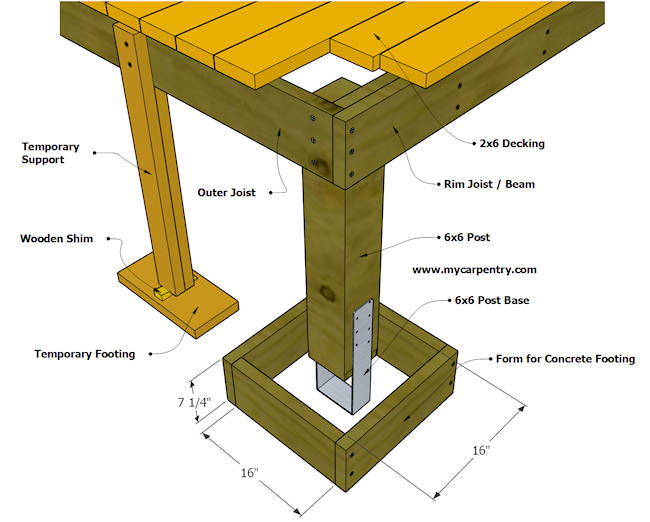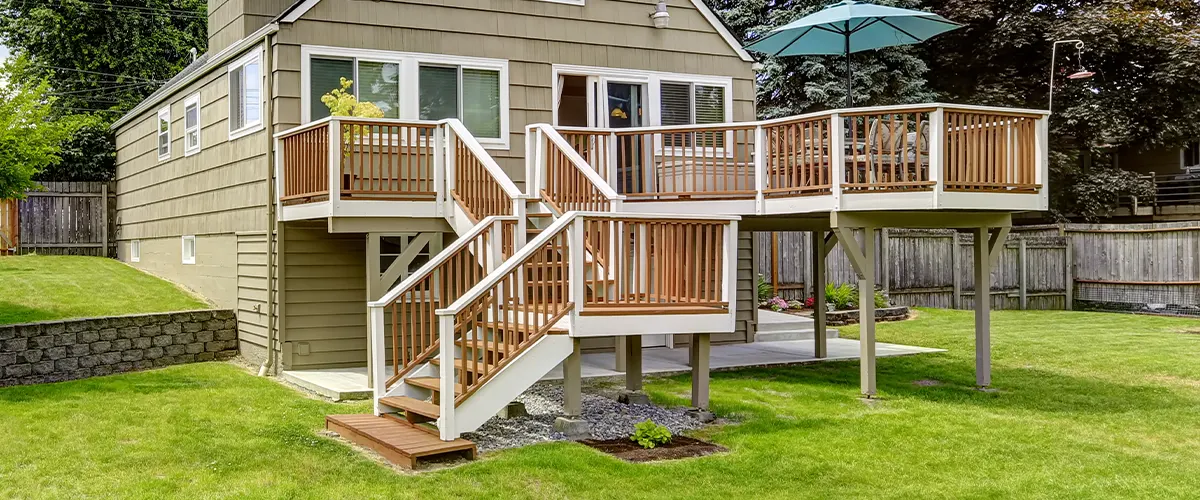Make Best Use Of the Lifespan of Your Deck With Strong and reputable Grounds
In order to fully optimize the life-span of your deck, it is essential to make certain that it is constructed on trusted and strong footings. These footings form the structure of your deck, giving stability and support, and are commonly the distinction between a deck that lasts for years and one that calls for constant repairs. In this conversation, we will certainly explore the value of reliable grounds, the different kinds of solid ground products, appropriate setup strategies, and exactly how to keep and inspect your deck's grounds to protect against damage.
Relevance of Dependable Footings
The value of trustworthy footings can not be overemphasized when it pertains to optimizing the life expectancy of your deck. The grounds function as the structure upon which the entire framework relaxes, providing stability and support. Without a strong ground, the deck is vulnerable to moving, sinking, and even collapse, which can dramatically lower its life-span and present safety and security dangers.

Selecting the right type of footing is also crucial. Employing a specialist to analyze the soil, layout the grounds, and make sure correct installment is extremely recommended.
Buying trusted grounds might entail additional cost and initiative upfront, however it is a worthwhile financial investment that will add to the lasting longevity and safety and security of your deck. By guaranteeing a solid foundation, you can appreciate your deck for several years to come, knowing that it is built to withstand the examination of time.
Kinds of Solid Ground Materials
To guarantee the stability and longevity of your deck, it is necessary to take into consideration the various sorts of strong ground products available. The option of footing material is important as it gives the needed assistance and security to endure the weight and load of the deck structure.
One dependable and usual material utilized for deck grounds is concrete. Concrete footings are long lasting and supply excellent stability. They can be poured directly into the ground or use precast concrete grounds for less complicated installment. Another option is helical piers, which are steel shafts with helical plates that are screwed right into the ground. These piers provide outstanding load-bearing ability and can be utilized in various dirt conditions.
For areas with bad dirt conditions, such as expansive or loosened dirts, a ground system that utilizes steel or composite piers may be preferred. Deck Footings. These piers are driven deep into the ground to reach secure soil layers, ensuring the security of the deck
In some instances, deck grounds can also be built making use of treated lumber. It is crucial to guarantee that the lumber is properly treated to stand up to rot and decay caused by direct exposure to wetness and insects.
When selecting a footing product for your deck, it is essential to think about factors such as soil problems, climate, and neighborhood structure codes. Consulting with a professional specialist or structural designer can aid figure out one of the most suitable footing product for your specific deck project.
Proper Installment Strategies for Grounds
Thinking about the relevance of making certain stability and durability for your deck, it is important to comprehend the appropriate installation techniques for grounds. The success of your deck project counts greatly on the honesty of its structure, which is why complying with the proper installation techniques is critical.
First and foremost, it is needed to determine the proper size and deepness of the grounds based upon the layout and load needs of your deck. This info can be obtained from building codes or via consultation with an architectural designer. As a general guideline, grounds ought to be at least 12 inches in size and prolong listed below the frost line to stop shifting or clearing up.
As soon as the dimensions are developed, the following action is excavation. Digging the holes for the grounds ought to be done with precision, ensuring they are deep enough and have a level base. Deck Footings. This will give a steady base for the grounds
To better improve the stability of the grounds, it is advised to utilize a concrete combine with a stamina of a minimum of 3,000 psi. This will certainly ensure the grounds can endure the weight and pressures applied by the deck.
Throughout installment, it is very important to maintain the footings degree and straightened effectively. This can be accomplished by utilizing a level and string lines to guide the positioning of each ground.
Preserving and Examining Your Deck's Footings
Normal upkeep and comprehensive evaluations are necessary for making sure the long-term stability and security of your deck's grounds. Over time, grounds can catch tear and wear, climate condition, and soil activity, which can compromise their structural honesty. To make best use of the life expectancy of your have a peek here deck's grounds, it is essential to carry out a normal upkeep regimen and conduct complete assessments.

Additionally, it is critical to evaluate grounds for any kind of signs of damages or damage. This includes checking for cracks, splits, or crumbling concrete, as well as any indications of movement or negotiation. Any kind of issues must be addressed quickly to avoid more damages and ensure the stability of the deck.
Moreover, it is suggested to evaluate the surrounding soil for any type of indications of erosion or moving. Dirt movement can impact the stability of the grounds, so it is crucial to attend to any kind of soil-related problems immediately.
Signs of Footing Damages and How to Address Them
Footing damages can present severe dangers to the stability and security of your deck, making it vital to promptly identify and attend to any type of indications of degeneration. One of one of the most common signs of footing damage is settling or sinking of the deck. This can happen because of dirt disintegration, insufficient grounds, or poor building methods. It is vital to take immediate activity to protect against further damage if you notice that your deck is uneven or leaning. Another indicator of footing damage is crumbling or cracking of the concrete footings. This can be triggered by freeze-thaw cycles, extreme moisture, or inadequate quality concrete. It is essential to have them examined and fixed by a specialist if you observe any kind of splits or degeneration in the footings. In addition, if you see any motion or changing of the deck, such as a deck that feels unsteady when strolled on or wobbles when weight is used, maybe look at this site an indicator of footing damages. In such instances, it is advised to seek advice from a specialist contractor or an architectural designer to assess the extent of the damages and establish the proper strategy. Keep in mind, addressing ground damages promptly can assist make sure the long-lasting stability and safety and security of your deck.
Final Thought
To conclude, guaranteeing the reliability and stamina of grounds is important for maximizing the lifespan of your deck. By utilizing strong footing materials and properly mounting them, you can protect against damages and keep the security of your deck. Normal maintenance and examinations will certainly likewise help recognize any type of indicators of footing damage and enable timely fixings. Ultimately, taking these measures will aid preserve the integrity and longevity of your deck.
These footings create the structure of your deck, giving security and support, and are typically the distinction in between a deck that lasts for years and one that requires constant repair services. In this discussion, we will explore the relevance of reliable grounds, the different types of solid footing products, correct installment strategies, and how to keep and inspect your deck's footings to prevent damage.Routine maintenance and comprehensive evaluations are crucial for ensuring the long-term security and security of your deck's grounds. Bear in mind, resolving ground damages without delay can aid make sure the long-lasting security and security of your deck.
By making use of strong footing materials and correctly installing them, you can stop damage and keep the security of your deck.
Comments on “Structural Honesty Matters: Picking the Right Deck Footings for Your Outdoor Job”